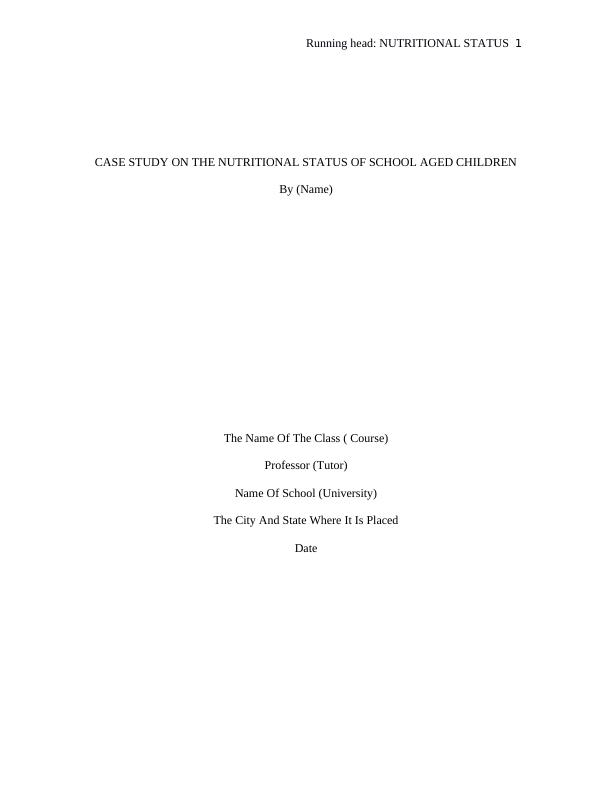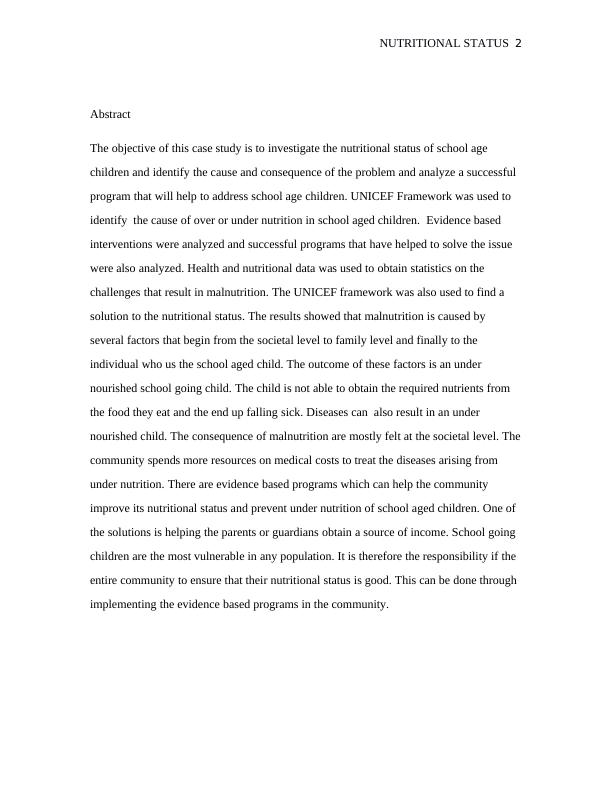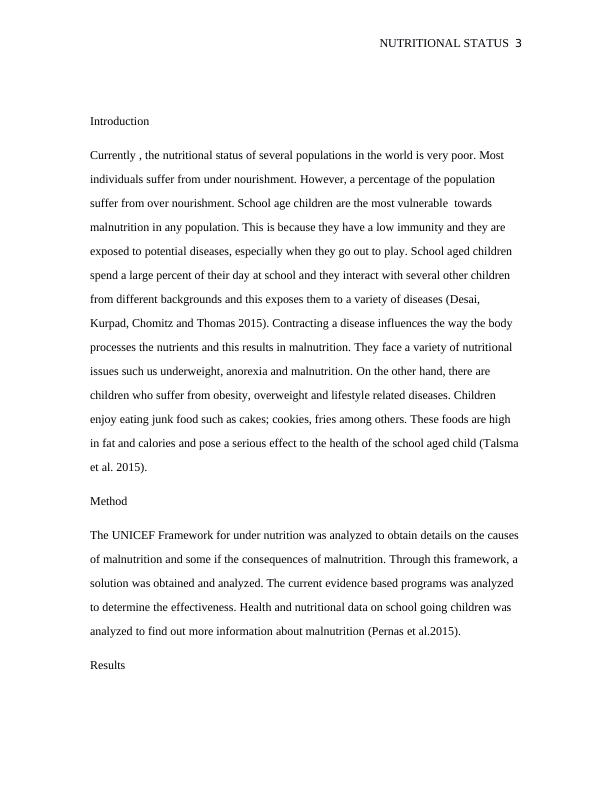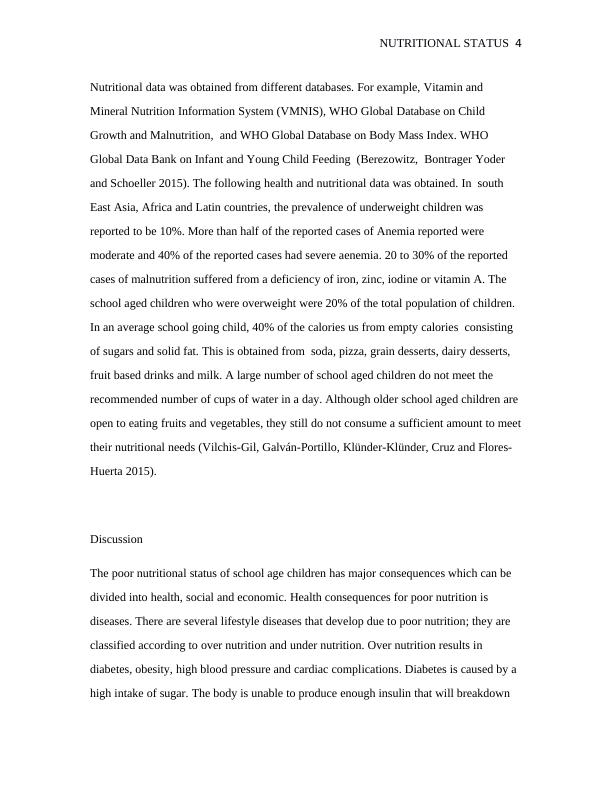Case Study on Nutritional Status of School Aged Children
Added on 2023-01-18
14 Pages4294 Words55 Views
Running head: NUTRITIONAL STATUS 1
CASE STUDY ON THE NUTRITIONAL STATUS OF SCHOOL AGED CHILDREN
By (Name)
The Name Of The Class ( Course)
Professor (Tutor)
Name Of School (University)
The City And State Where It Is Placed
Date
CASE STUDY ON THE NUTRITIONAL STATUS OF SCHOOL AGED CHILDREN
By (Name)
The Name Of The Class ( Course)
Professor (Tutor)
Name Of School (University)
The City And State Where It Is Placed
Date

NUTRITIONAL STATUS 2
Abstract
The objective of this case study is to investigate the nutritional status of school age
children and identify the cause and consequence of the problem and analyze a successful
program that will help to address school age children. UNICEF Framework was used to
identify the cause of over or under nutrition in school aged children. Evidence based
interventions were analyzed and successful programs that have helped to solve the issue
were also analyzed. Health and nutritional data was used to obtain statistics on the
challenges that result in malnutrition. The UNICEF framework was also used to find a
solution to the nutritional status. The results showed that malnutrition is caused by
several factors that begin from the societal level to family level and finally to the
individual who us the school aged child. The outcome of these factors is an under
nourished school going child. The child is not able to obtain the required nutrients from
the food they eat and the end up falling sick. Diseases can also result in an under
nourished child. The consequence of malnutrition are mostly felt at the societal level. The
community spends more resources on medical costs to treat the diseases arising from
under nutrition. There are evidence based programs which can help the community
improve its nutritional status and prevent under nutrition of school aged children. One of
the solutions is helping the parents or guardians obtain a source of income. School going
children are the most vulnerable in any population. It is therefore the responsibility if the
entire community to ensure that their nutritional status is good. This can be done through
implementing the evidence based programs in the community.
Abstract
The objective of this case study is to investigate the nutritional status of school age
children and identify the cause and consequence of the problem and analyze a successful
program that will help to address school age children. UNICEF Framework was used to
identify the cause of over or under nutrition in school aged children. Evidence based
interventions were analyzed and successful programs that have helped to solve the issue
were also analyzed. Health and nutritional data was used to obtain statistics on the
challenges that result in malnutrition. The UNICEF framework was also used to find a
solution to the nutritional status. The results showed that malnutrition is caused by
several factors that begin from the societal level to family level and finally to the
individual who us the school aged child. The outcome of these factors is an under
nourished school going child. The child is not able to obtain the required nutrients from
the food they eat and the end up falling sick. Diseases can also result in an under
nourished child. The consequence of malnutrition are mostly felt at the societal level. The
community spends more resources on medical costs to treat the diseases arising from
under nutrition. There are evidence based programs which can help the community
improve its nutritional status and prevent under nutrition of school aged children. One of
the solutions is helping the parents or guardians obtain a source of income. School going
children are the most vulnerable in any population. It is therefore the responsibility if the
entire community to ensure that their nutritional status is good. This can be done through
implementing the evidence based programs in the community.

NUTRITIONAL STATUS 3
Introduction
Currently , the nutritional status of several populations in the world is very poor. Most
individuals suffer from under nourishment. However, a percentage of the population
suffer from over nourishment. School age children are the most vulnerable towards
malnutrition in any population. This is because they have a low immunity and they are
exposed to potential diseases, especially when they go out to play. School aged children
spend a large percent of their day at school and they interact with several other children
from different backgrounds and this exposes them to a variety of diseases (Desai,
Kurpad, Chomitz and Thomas 2015). Contracting a disease influences the way the body
processes the nutrients and this results in malnutrition. They face a variety of nutritional
issues such us underweight, anorexia and malnutrition. On the other hand, there are
children who suffer from obesity, overweight and lifestyle related diseases. Children
enjoy eating junk food such as cakes; cookies, fries among others. These foods are high
in fat and calories and pose a serious effect to the health of the school aged child (Talsma
et al. 2015).
Method
The UNICEF Framework for under nutrition was analyzed to obtain details on the causes
of malnutrition and some if the consequences of malnutrition. Through this framework, a
solution was obtained and analyzed. The current evidence based programs was analyzed
to determine the effectiveness. Health and nutritional data on school going children was
analyzed to find out more information about malnutrition (Pernas et al.2015).
Results
Introduction
Currently , the nutritional status of several populations in the world is very poor. Most
individuals suffer from under nourishment. However, a percentage of the population
suffer from over nourishment. School age children are the most vulnerable towards
malnutrition in any population. This is because they have a low immunity and they are
exposed to potential diseases, especially when they go out to play. School aged children
spend a large percent of their day at school and they interact with several other children
from different backgrounds and this exposes them to a variety of diseases (Desai,
Kurpad, Chomitz and Thomas 2015). Contracting a disease influences the way the body
processes the nutrients and this results in malnutrition. They face a variety of nutritional
issues such us underweight, anorexia and malnutrition. On the other hand, there are
children who suffer from obesity, overweight and lifestyle related diseases. Children
enjoy eating junk food such as cakes; cookies, fries among others. These foods are high
in fat and calories and pose a serious effect to the health of the school aged child (Talsma
et al. 2015).
Method
The UNICEF Framework for under nutrition was analyzed to obtain details on the causes
of malnutrition and some if the consequences of malnutrition. Through this framework, a
solution was obtained and analyzed. The current evidence based programs was analyzed
to determine the effectiveness. Health and nutritional data on school going children was
analyzed to find out more information about malnutrition (Pernas et al.2015).
Results

NUTRITIONAL STATUS 4
Nutritional data was obtained from different databases. For example, Vitamin and
Mineral Nutrition Information System (VMNIS), WHO Global Database on Child
Growth and Malnutrition, and WHO Global Database on Body Mass Index. WHO
Global Data Bank on Infant and Young Child Feeding (Berezowitz, Bontrager Yoder
and Schoeller 2015). The following health and nutritional data was obtained. In south
East Asia, Africa and Latin countries, the prevalence of underweight children was
reported to be 10%. More than half of the reported cases of Anemia reported were
moderate and 40% of the reported cases had severe aenemia. 20 to 30% of the reported
cases of malnutrition suffered from a deficiency of iron, zinc, iodine or vitamin A. The
school aged children who were overweight were 20% of the total population of children.
In an average school going child, 40% of the calories us from empty calories consisting
of sugars and solid fat. This is obtained from soda, pizza, grain desserts, dairy desserts,
fruit based drinks and milk. A large number of school aged children do not meet the
recommended number of cups of water in a day. Although older school aged children are
open to eating fruits and vegetables, they still do not consume a sufficient amount to meet
their nutritional needs (Vilchis-Gil, Galván-Portillo, Klünder-Klünder, Cruz and Flores-
Huerta 2015).
Discussion
The poor nutritional status of school age children has major consequences which can be
divided into health, social and economic. Health consequences for poor nutrition is
diseases. There are several lifestyle diseases that develop due to poor nutrition; they are
classified according to over nutrition and under nutrition. Over nutrition results in
diabetes, obesity, high blood pressure and cardiac complications. Diabetes is caused by a
high intake of sugar. The body is unable to produce enough insulin that will breakdown
Nutritional data was obtained from different databases. For example, Vitamin and
Mineral Nutrition Information System (VMNIS), WHO Global Database on Child
Growth and Malnutrition, and WHO Global Database on Body Mass Index. WHO
Global Data Bank on Infant and Young Child Feeding (Berezowitz, Bontrager Yoder
and Schoeller 2015). The following health and nutritional data was obtained. In south
East Asia, Africa and Latin countries, the prevalence of underweight children was
reported to be 10%. More than half of the reported cases of Anemia reported were
moderate and 40% of the reported cases had severe aenemia. 20 to 30% of the reported
cases of malnutrition suffered from a deficiency of iron, zinc, iodine or vitamin A. The
school aged children who were overweight were 20% of the total population of children.
In an average school going child, 40% of the calories us from empty calories consisting
of sugars and solid fat. This is obtained from soda, pizza, grain desserts, dairy desserts,
fruit based drinks and milk. A large number of school aged children do not meet the
recommended number of cups of water in a day. Although older school aged children are
open to eating fruits and vegetables, they still do not consume a sufficient amount to meet
their nutritional needs (Vilchis-Gil, Galván-Portillo, Klünder-Klünder, Cruz and Flores-
Huerta 2015).
Discussion
The poor nutritional status of school age children has major consequences which can be
divided into health, social and economic. Health consequences for poor nutrition is
diseases. There are several lifestyle diseases that develop due to poor nutrition; they are
classified according to over nutrition and under nutrition. Over nutrition results in
diabetes, obesity, high blood pressure and cardiac complications. Diabetes is caused by a
high intake of sugar. The body is unable to produce enough insulin that will breakdown

End of preview
Want to access all the pages? Upload your documents or become a member.
Related Documents
Malnutrition in Children in Ethiopialg...
|14
|4262
|97
Nutrition Problem in Indialg...
|14
|3783
|83
Introduction to Healthcare in Australialg...
|7
|1549
|19
(PDF) A descriptive study on Malnutritionlg...
|16
|4072
|20
Child Malnutrition - Assignmentlg...
|15
|3935
|43
Improving Nutritionlg...
|10
|2038
|31
